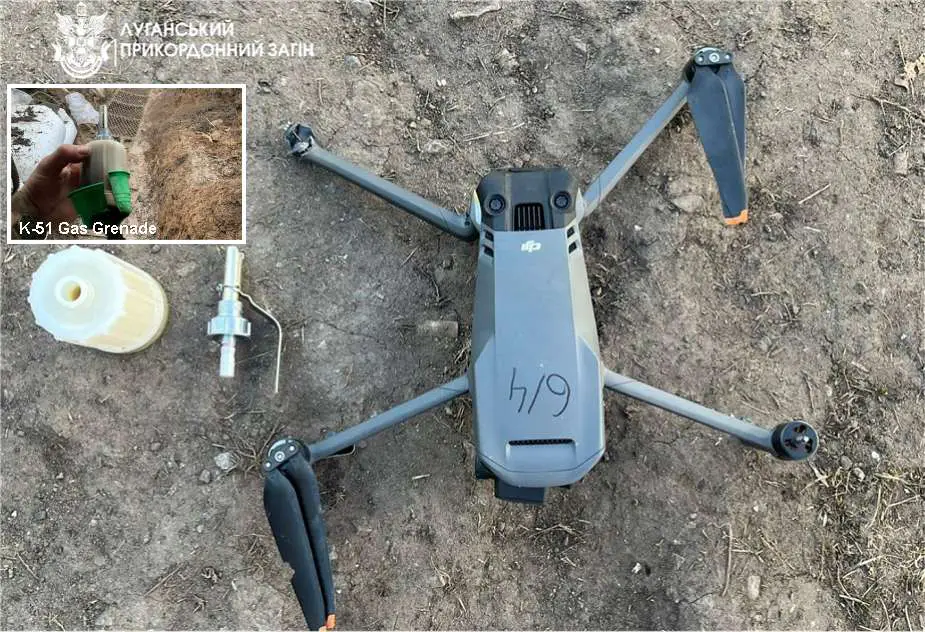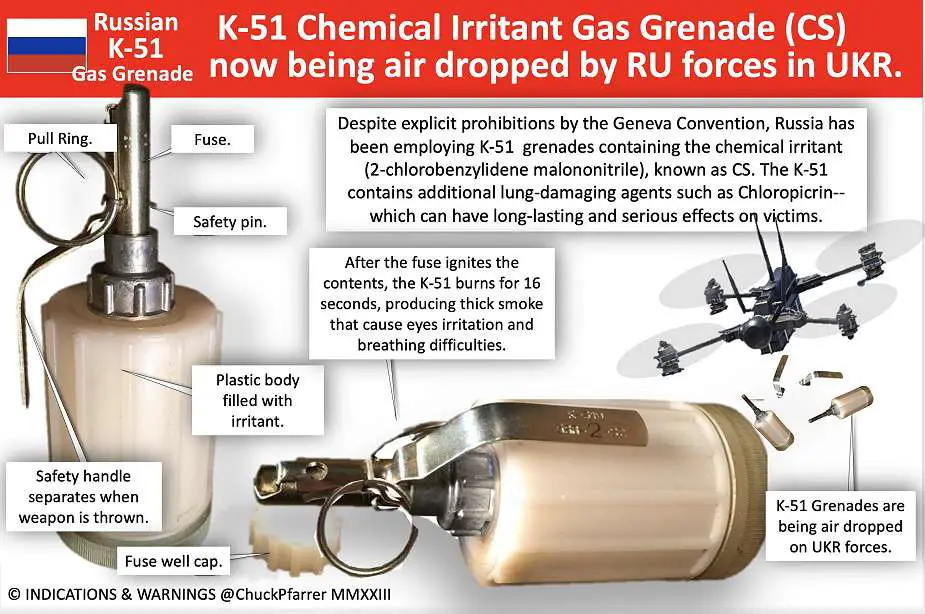Breaking news
Breaking News: Russian Forces Use Chemical K-51 Gas Grenades Dropped by Drones in Ukraine.
According to a report by the Institute for the Study of War dated December 23, 2023, it has been confirmed that the 810th Naval Infantry Brigade of Russia's Black Sea Fleet is deliberately using K-51 CS gas grenades against Ukrainian forces. This action constitutes a clear violation of the Chemical Weapons Convention, of which Russia is a signatory. (Thank you to @ChuckPfarrer for the drawing of the K-51 grenade dropped by drone)
Follow Army Recognition on Google News at this link

Russian forces use K-51 gas grenades dropped by quadcopter drones to strike Ukrainian soldiers. (Picture source Facebook State Border Service of Ukraine)
The State Border Service of Ukraine released a photo on their Facebook account showing the use of K-51 chemical gas grenades, dropped by drones in the Donetsk region. These grenades contain CS gas, commonly known as tear gas, and are used in riot control, which is classified as a Riot Control Agent (RCA). The use of RCAs in warfare is prohibited under the Chemical Weapons Convention, an international treaty that Russia has been a part of since 1997.
Further underlining this breach of international law, the 810th Naval Infantry Brigade posted a detailed message on its Telegram channel on December 22, 2023. The post outlined a "radical change in tactics" being employed against Ukrainian forces in Krynky, on the eastern bank of Kherson Oblast. It detailed how the brigade has rotated its forces into the Krynky area, utilizing a new tactic of dropping K-51 chemical gas grenades from drones. The stated objective of this tactic is to flush Ukrainian forces out of their positions and make them vulnerable to attacks from various weapons.
In addition to the written post, the 810th Naval Infantry Brigade also published footage that appears to show a K-51 grenade being dropped on a Ukrainian position, presumably in Krynky. The Institute for the Study of War noted that this is not the first instance of such tactics being used; Russian forces had previously deployed K-51 grenades against Ukrainian positions in Donetsk Oblast as early as November 2022.

In Ukraine, the K-51 chemical irritant gas grenade is dropped by quadcopter drones. (Picture source Twitter @ChuckPfarrer)
The adaptation of the K-51 chemical gas grenade for drone deployment introduces a novel and significant threat to Ukrainian soldiers in the field. Originally designed as a base-emission, striker-release hand grenade, this Russian-made weapon is primarily filled with CS gas (2-Chlorobenzalmalononitrile). The use of drones to deliver these grenades not only extends their operational reach but also enhances their tactical effectiveness in combat scenarios.
CS gas, the primary agent in the K-51, is a well-known riot control substance. It acts as a powerful irritant, affecting the tear glands to induce excessive tearing, and causing discomfort in the respiratory system and on the skin. Chemically, CS gas is a nitrile, featuring a cyano group (-C≡N) attached to a benzene ring, which is further modified with a chlorine atom and a malononitrile group. Although non-lethal, the gas can cause significant temporary distress and disorientation.
The controversy surrounding CS gas for crowd control due to health and safety concerns is further amplified when the K-51 is used in conjunction with drones. Drone deployment allows for a more remote, precise, and potentially more extensive dispersal of the irritant agent, raising ethical and legal questions, especially under international law regarding chemical weapons.
The K-51 grenade is designed with the K-510 fuze, a modification of the UZRG-M (УЗРГ-М) grenade fuze series. This fuze is shorter and features an internal thread, making it suitable for drone deployment. Once activated, the grenade produces a thick CS smoke for about 16 seconds. The use of drones to drop these grenades adds a new dimension to their application, allowing for a broader and more strategic deployment in various operational contexts.























